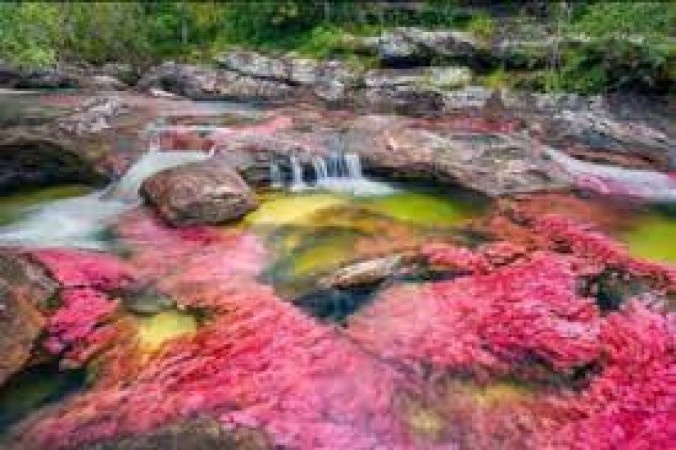
Water, the essence of life, flows in various forms and colors across the world, painting a vibrant tapestry of landscapes and ecosystems. From azure blue to emerald green, each hue tells a unique story of geological, chemical, and environmental processes. Let's embark on a journey to explore five distinct colored waterways that grace our planet.
The Caribbean Sea boasts some of the clearest and most breathtakingly blue waters on Earth. This vibrant hue is a result of the region's shallow depths, which allow sunlight to penetrate the water column, scattering blue wavelengths and creating a mesmerizing azure tint. The absence of suspended particles further enhances the clarity, offering a stunning backdrop for coral reefs and marine life.
Beneath the surface, coral reefs contribute to the Caribbean's azure beauty. These underwater ecosystems harbor a myriad of colorful organisms, including corals, fish, and sponges, which reflect and refract light, intensifying the blue spectrum. Additionally, the absence of sedimentation and pollution preserves the water's pristine clarity, sustaining the region's vibrant marine biodiversity.
In the heart of South America, the Amazon River meanders through lush rainforests, its waters adorned with a distinctive turquoise hue. This coloration is attributed to suspended sediment particles, predominantly clay and silt, which reflect sunlight and scatter shorter wavelengths, resulting in a striking turquoise tint. The river's vast expanse and sediment-laden flow create a captivating contrast against the surrounding green canopy.
The Amazon rainforest, often referred to as the "lungs of the Earth," plays a crucial role in shaping the river's turquoise appearance. Intense rainfall and erosion processes within the basin continuously supply sediment to the waterways, imparting their characteristic color. Despite the sediment load, the Amazon's waters support a rich ecosystem, sustaining countless species of flora and fauna.
Nestled amidst New Zealand's picturesque landscapes, the country's emerald lakes captivate visitors with their stunning greenish hues. These glacial lakes owe their color to finely ground rock flour, produced by the grinding action of glaciers against bedrock. Suspended in the water, the rock flour scatters light, reflecting green wavelengths and giving the lakes their distinctive emerald appearance.
The presence of glaciers in New Zealand's mountainous regions contributes significantly to the formation of emerald lakes. As glaciers advance and retreat, they erode the surrounding terrain, grinding rocks into fine particles. When these particles enter the lakes, they remain suspended in the water, coloring it with varying shades of green. Despite their frigid temperatures, these lakes support unique ecosystems adapted to the glacial environment.
Australia's Pink Lake, situated along the country's western coast, mesmerizes visitors with its surreal pink hue. The lake's distinctive coloration is caused by a combination of factors, including high salinity levels, algae, and halophilic bacteria. These microorganisms produce carotenoid pigments, such as beta-carotene, which impart a rosy tint to the water, particularly evident during dry seasons.
Pink Lake's salinity levels, exceeding that of seawater, create an inhospitable environment for many organisms but provide an ideal habitat for halophilic bacteria and algae. These microorganisms thrive in the saline conditions, producing pigments that color the water pink. The lake's unique appearance, coupled with its surrounding landscapes, attracts tourists seeking to witness nature's captivating spectacle.
Iceland's glacial rivers, born from the country's ice-capped mountains, exhibit a distinct grayish hue that sets them apart from other water bodies. The coloration is primarily attributed to glacial flour, fine sediment generated by the grinding of rocks beneath moving glaciers. As glacial meltwater flows downstream, it carries suspended particles, imparting a milky-gray appearance to the rivers.
Iceland's dynamic glacial landscapes play a pivotal role in shaping the color of its rivers. As glaciers advance, they scour the underlying bedrock, producing a fine powder known as glacial flour. When this flour enters the rivers, it remains suspended in the water column, giving it a distinctive grayish tint. Despite their muted color, Iceland's glacial rivers are vital ecosystems, supporting diverse aquatic life forms.
In conclusion, the world's colored waterways offer a glimpse into the intricate interplay of geological processes, environmental conditions, and biological interactions. From the azure blue of the Caribbean to the grayish hues of Iceland's glacial rivers, each color tells a unique story of the Earth's diverse landscapes and ecosystems.
Tata Motors increased the prices of commercial vehicles by 2 percent, will be effective from April 1
BYD electric sedan launched in India, will compete with Hyundai Ioniq 5